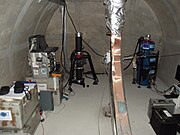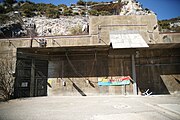User:Lsbblsbb/Low background noise interdisciplinary ground and underground based research laboratory
| File:LogoLSBB.jpg | |
| Country | |
|---|---|
| Coordinates | 43°55′43″N 5°29′13″E / 43.92865°N 5.48705°E |
The low background noise interdisciplinary ground and underground based research laboratory (LSBB, CNRS Mixed Service Unit) contributes to the development of knowledge and know-how at national, European and international levels. As an interdisciplinary research facility, the LSBB is able to (i) accommodate large instruments, (ii) host scientific platforms, (iii) provide real-time measurements to national observatories, (iv) develop and to welcome ultra-sensitive multiphysics instrumentations of both academic and industrial collaborations in a low-anthropic-noise environment with particular interest in geological, electromagnetic and hydrogeological fields.
Underground Low Noise Laboratory (LSBB) is a research laboratory founded in 1997 in Rustrel, Vaucluse.
History[edit]


After 25 years of operational service, the fire control station Number 1 of the strategic ballistic ground weapon system of the French nuclear deterrent force on the Albion plateau, located in Rustrel in Vaucluse, in the Pays d'Apt and in the Luberon Regional Natural Park, is converted into a multidisciplinary scientific laboratory.
The laboratory is supported by the Community of Communes of the Pays d'Apt, the General Council of Vaucluse and the Provence-Alpes-Côte d'Azur region, the universitie of Avignon the CNRS-INSU, the University of British Columbia in Vancouver and the Geosciences Department of the University of Berkeley.
It was founded by Georges Waysand in 1997 and the current director is Stéphane Gaffet, CNRS seismologist at Géosciences Azur, Sophia Antipolis.




At the heart of the largest karst spring catchment in Europe and in the Regional Natural Park of Luberon, the LSBB enjoys a unique natural environment that guarantees a low level of human disturbance and provides access to privileged underground particular medium: (i) epikarst and the deep and superficial unsaturated zone of the karst aquifer Fountain Vaucluse, (ii) a similar carbonate platform of Middle East oil fields, (iii) the region of major faults seismogenic Provence. The LSBB, labeled website instrumented INSU has become: A seismic observatory environmental, hydrogeological, and magnetic radiation, a privileged site for the high-resolution mass transfer study (gas, water, solutes) under natural conditions and / or under stress, in a heterogeneous environment to multiscale complexity such as karst, an LBNL partner (Berkeley), UBC (Vancouver) and DUSEL (Sanford) for the formalization of a global network of underground laboratories for interdisciplinary scientific innovation in different fields of electronics micro nano, detection of local natural events and global, energy and environmental technologies; The lab also become candidate in the PACA region a pre-industrial pilot platform for the development of technologies and monitoring methodologies, complementary sites and existing initiatives in Europe. A LBNL partner (Berkeley), UBC (Vancouver) and DUSEL (Sanford) for the formalization of a global network of interdisciplinary underground laboratories for scientific innovation in different fields of electronics micro nano, detection local and global natural events, energy and environmental technologies; The lab also become candidate in the PACA region a pre-industrial pilot platform for the development of technologies and monitoring methodologies, complementary sites and existing initiatives in Europe. A LBNL partner (Berkeley), UBC (Vancouver) and DUSEL (Sanford) for the formalization of a global network of interdisciplinary underground laboratories for scientific innovation in different fields of electronics micro nano, detection local and global natural events, energy and environmental technologies; The lab also become candidate in the PACA region a pre-industrial pilot platform for the development of technologies and monitoring methodologies, complementary sites and existing initiatives in Europe. microelectronics to nano, detection of local natural events and global, energy and environmental technologies; The lab also become candidate in the PACA region a pre-industrial pilot platform for the development of technologies and monitoring methodologies, complementary sites and existing initiatives in Europe. microelectronics to nano, detection of local natural events and global, energy and environmental technologies; The lab also become candidate in the PACA region a pre-industrial pilot platform for the development of technologies and monitoring methodologies, complementary sites and existing initiatives in Europe.
Research topics at LSBB[edit]
- Karst hydrogeology: UMR EMMAH Mediterranean Environment and Modeling of Agro-Hydrosystems
- Few karst systems allow access to their unsaturated zone (ZNS) and therefore to the study of the latter. Depending on its size, it is however an important element in the functioning of the system. : The LSBB offers a unique access to the ZNS of the Fontaine de Vaucluse basin (from 30 to 500 m deep). It also provides the mesoscale and the interdisciplinary framework essential for characterizing the functioning of this ZNS.
- seismology, site effects of earthquakes ;
- study of good protocols for carbon dioxide storage
- microwave geophysical imaging
- reliability of microelectronics
ionospheric magnetometry
The coincidence of 3 themes (hydrogeological, magnetic and seismic) has already identified a correlation between magnetic field, seismic waves and hydrogeological properties of karst. Strong earthquakes (magnitude greater than 7) are capable of causing displacements of the order of a millimeter at 10,000 km distance (teleseism).
- he sensitivity of the magnetometer implanted at LSBB ([SQUID] ² = [Superconducting QUantum Interference Device] with [Shielding QUalified for Ionosphere Detection].) Allows us to observe a variation in the synchronous local magnetic field following the passage of waves and following this movement. This variation was attributed to an electrokinetic coupling generated in the infiltration waters of the karst massif surrounding the LSBB.
- SPRITES detection
Infrastructure[edit]
4 km from subhorizontal tunnels dug in the limestone massif karstified the heart of NAOS, 300 m blast gallery 280 m deep with easy access to the rock only covered with a flock of cement, and a new 2*150-metre gallery for the observation of gravitational waves http://miga-project.org/
2 axes de galeries approximativement perpendiculaires (80°) offrant des portions rectilignes de 800 m et 1250 m de long,
5 core drilling of 21 m depth and 146 mm in diameter, 280 m below the ground surface, for process instrumentation associated with the poroelastic deformation and drilling sensors tests,
An electromagnetically shielded environment including a cured cavity 28 m long and 8 m in diameter, filtering the earth's magnetic field fluctuations for frequencies higher than 50 Hz with a lower residual field to 2 × 10 -15 T
Distribution of GPS time ( NMEA pulses and frame) by optical fiber in all galleries,
Internet Network Gigabit optical fiber throughout the galleries connected by drilling to the surface at the top of the solid in which there is the LSBB, with access to 600Mb / s outwardly
isolated rooms for installation of sensors providing time synchronization, power supply, and access Internet telephony,
Clean room, for mounting detectors requiring optimal purity conditions (eg SIMPLE detector, water purification of the LINES long base inclinometer, ...),
On the surface, access to all the plumbs of the galleries and infrastructure at the top of the structure that can accommodate observation equipment (equipment identical to that of the galleries),
Geographic reference system in all galleries, deployed by IGN since 2002 and linked to the French geographic reference system (RGF 93),
220 V and 380 V power supply hardened in all galleries and in the anti-blast gallery.
Water supply possible in all galleries.
Science and society[edit]
The LSBB participates in heritage days (650 people attended the establishment in 2010, 1,100 in 2016).
The LSBB is the creator of the biannual international iDUST conferences. The organization of certain transfers (2008, 2010, 2012) was built in collaboration with the Vélo Théâtre d'Apt and the town hall of Apt, with a link between scientific and artistic research accessible to the public. The 2010 edition gave rise to the performance of the show Le t de n-1 by the troupe in residence Les Ateliers du Spectacle [1].
The LSBB has been a partner in the intercommunal cultural project in the Pays d'Apt and works with the resident artist Utopies [2].
Heritage[edit]
he Rustrel laboratory represents 4 km of tunnels and 53 ha on the surface. The site itself is the property of the community of communes of the Pays d'Apt-Luberon (CCPAL) [3], the CNRS benefiting from an emphyteutic lease for its occupation.
The emblematic part undoubtedly remains the 1,250 m3 armored capsule where two shooting officers were sitting awaiting a possible order from the President of the Republic.
Externals links[edit]
- Site du laboratoire
- Visite du laboratoire sur le site de France Bleu Vaucluse
[[Category:Vaucluse]] [[Category:Underground laboratories]] [[Category:WikiProject Europe articles]] [[Category:WikiProject France articles]] [[Category:Pages with unreviewed translations]]
- ^ [dead link]
- ^ "dreams for tomorrow". Utotopies. Retrieved October 18, 2016.
